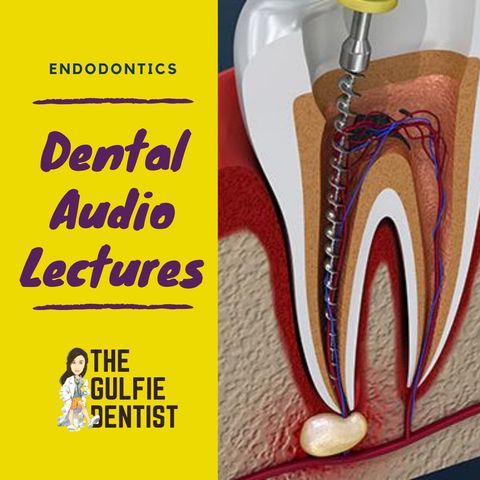53. Discolourations

Scarica e ascolta ovunque
Scarica i tuoi episodi preferiti e goditi l'ascolto, ovunque tu sia! Iscriviti o accedi ora per ascoltare offline.
Descrizione
DISCOLOURATIONS YELLOWISH- WHITE - Pulp is inflammed & calcified, non-necrotic - It is calcific metamorphosis - No infection here. Tertiary dentine in formed extensively - Dystrophic calcification, pulp stones may...
mostra di piùYELLOWISH- WHITE
- Pulp is inflammed & calcified, non-necrotic
- It is calcific metamorphosis
- No infection here. Tertiary dentine in formed extensively
- Dystrophic calcification, pulp stones may be seen
- If asymptomatic – RCT not required – give crown directly
YELLOWISH GREY TO BROWN / RED
- Pulp is dead & undergoing necrotic changes
- Do RCT, some bleach ( GP up to middle 3rd only then rest fill up with GIC – tight seal, because hydrogen peroxide must not fall into the canal
- Go for crown if needed
TETRACYCLINE STAINS
- Yellow brown stain seen in adults
- If pregnant mothers take tetracycline – child’s primary teeth will be affected
- If child takes tetracycline during early ages – permanent dentition will be affected
- Mechanism – during the stage of tooth formation, tetracycline bonds to teeth instead of Calcium
- Treatment :– if mild bleaching ; if severe veneer / crown
PINK TOOTH OF MURMERY
- Internal resorption
- Pulp is enlarged & hyperactive
- Enamel shell shows off the pulp ( because dentine is resorbed here )
- 90% seen in primary teeth
- Cause is unknown ……….. Due to inflammatory reaction?
- This the reason why DPC is contra-indicated in primary teeth. CaOH is of 12Ph, which will irritate the pulp thus initiating the inflammation
- Irreversible type of pulpitis
- Radiograph – isolated radiolucency, & not moth-eaten appearance
- If asymptomatic, thus usually found during routine radiographs
Treatment – single sitting pulpectomy / RCT
- If symptomatic, pulp extirpation – followed by CaOH
(Pulp chamber which is highly acidic will be neutralized by CaOH)
CYSTIC FIBROSIS
- They are on tetracycline, thus the stains
- They always have a variety of infections
- Key feature - thick secretions
ERYTHROBLASTOSIS FETALIS
- Yellow molars
- Bleaching is the treatment, if required only
- Treatment not necessary
PORPHYRINE STAINS
- Red stains
AMALGAM BLUEING
- Blueish black discoloration due to amalgam
BLEACHING
Bleaching is the removal of stains that has been formed on the organic content of the tooth.
A. NONVITAL TOOTH
1. THERMOCATALYTIC TECHNIQUE
Material used – hydrogen peroxide – 30%
After RCT – remove GP from the coronal top – place GIC filling – about 2mm as protective
cement barrier – Place the oxiding agent – 30% hydrogen peroxide- SUPEROXOL – inside the
chamber & apply heat
Done in office set up
Done intracoronally – because its more effective.
Dangerous – must not fall into the canal, in the oral mucosa, due to high concentration of
hydrogen peroxide
2. WALKING BLEACHING
Material used – sodium perborate
Place mixuture of sodium perborate + water inside the chamber
Changed every 4-7 days
Finish in 2-6 weeks.
In-home bleaching technique
Safer than superoxol
B. VITAL TOOTH
IMMEDIATELY AFTER BLEACHING, COMPOSITE IS CONTRAINDICATED – because the content of bleaching agent will hinder the polymerization of composite – therefore always delay the composite restoration by 1 week – by placing temporary restoration for that time period
Informazioni
| Autore | DrMayakha Mariam |
| Organizzazione | DrMayakha Mariam |
| Sito | - |
| Tag |
-
|
Copyright 2024 - Spreaker Inc. an iHeartMedia Company
